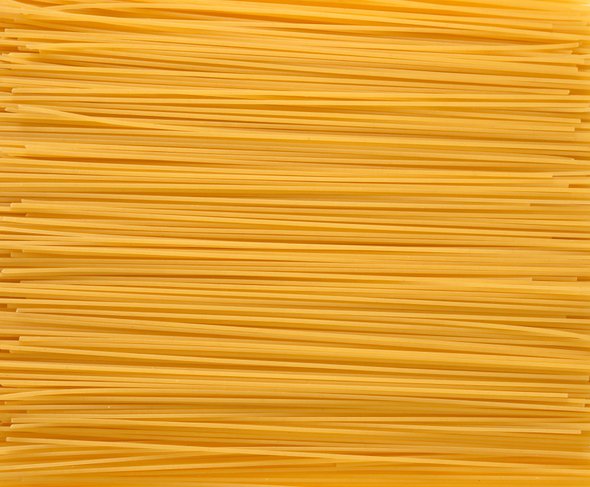(单词翻译:单击)
听力文本
This is Scientific American — 60-Second Science. I'm Karen Hopkin.
Physicists concern themselves with problems that are profound. The origins of the universe, the nature of time, the composition of matter. And then, there's spaghetti. A pasta problem has perplexed physicists as celebrated as Richard Feynman, and has even been awarded an Ig Nobel prize. At issue:
"Why spaghetti doesn't break into two pieces. Why it breaks into three pieces or more."
Ronald Heisser, now a grad student at Cornell, decided to explore the misbehavior of spaghetti for an undergraduate math course he took at MIT.
Now, you may never have noticed it, but it's nearly impossible to break a single, dry piece of spaghetti in half. Feynman allegedly noodled with the puzzle. And Heisser became similarly possessed.
"I'm a little bit of a contrarian person. So I thought it would be fun to try and break it into two. 'Cause no one said you couldn't do that. They just said why it doesn't break into two."
In fact, the French researchers who were awarded the Ig Nobel prize in 2006 found that when spaghetti is bent evenly from both ends it will crack near the center, where the stick is most curved. But this initial break sets up a vibrational wave that quickly fractures the rod further. So you get multiple fragments.
What Heisser wondered was whether he could somehow get around this vibrational "snapback" effect. And he found you have to do the twist. Heisser built a device for torquing his pasta with precision and he observed the resulting fragmentation with a high-speed camera. He discovered that introducing a twist of around 360 degrees to the long strand allowed him to produce the desired single pair of pasta pieces.

That's where Vishal Patil, a grad student in mathematics at MIT, comes in:
"So I first heard about this spaghetti problem from coauthors Ronald Heisser and Professor Jörn Dunkel when I first arrived at MIT...and after hearing about this problem, I became interested in developing mathematical models for the fracture of this elastic rod. And in particular, to see if using this model you could find out ways to control the fracture in the rod."
Controlling fractures is a big issue in materials science and could have applications in everything from the design of highways and bridges to the engineering of nanotubes.
Patil's modeling showed that twisting the spaghetti dampens the snapback effect. That's because once the twisted stick is broken, it will try to unwind. This rapid unwinding creates a "twisting wave" that basically blocks the vibrational snapback wave, leaving the spaghetti in two clean pieces. The work is served up in the Proceedings of the National Academy of Sciences.
VP: "Although the project was a bit of fun I think it's quite nice when you can find interesting physics and maths lurking behind everyday, sort of mundane objects."
Thanks for listening for Scientific American — 60-Second Science. I'm Karen Hopkin.
参考译文
这里是科学美国人——60秒科学。我是凯伦·霍普金。
物理学家关心的是那些深奥的问题。比如,宇宙起源、时间的本质、物质的构成等等。还有,意大利面。意大利面问题困扰着像理查德·费曼这样著名的物理学家,这个问题甚至还获得了搞笑诺贝尔奖。他们关心的问题是:
“为什么意大利面不会断成两截?而是断成三截或更多?”
罗纳德·海瑟是康奈尔大学的在读研究生,他在麻省理工学院读本科时,决定在数学课程中研究意大利面的不正常现象。
到目前为止,你可能从未注意过这种现象,但是要将一根干意大利面掰成两段几乎是不可能的事情。据说费曼钻研过这个谜题。而海瑟也开始对这个谜题着迷。
“我是有些逆向思维的人。所以,我认为试着将意大利面掰成两段会很有趣。因为没有人说过不能这样做。他们只是在问‘为什么意大利不能断成两截?'”
事实上,获得2006年搞笑诺贝尔奖的法国研究人员发现,当意大利从两端均匀弯曲时,会从最弯曲的中心位置附近断裂。但最初的断裂会产生振动波,使面条迅速继续断裂。这样一来,意大利面就会断成好几段。
海瑟想知道的是,他能否以某种方式避免这种振动“迅速回弹”效应。他发现,必须要将意大利弯曲。海瑟制造了一个精确弯曲意大利面的装置,他用高速摄像机观察了最终断裂结果。他发现,将一根长条意大利面扭转接近360度后,可以得到他想要的断成两段的意面。
然后,麻省理工学院的数学系研究生维沙尔·帕蒂尔加入了进来:
“我第一次听说意大利面问题,是我刚到麻省理工学院时,从该研究的共同作者罗纳德·海瑟和约恩·邓克尔教授那里听到的,听说这个问题之后,我开始对为这种弹性面条的断裂开发数学模型产生兴趣。特别是,我想看看能否用这个模型找到控制面条断裂的方法。”
断裂控制在材料学中是一个重要问题,其可应用于从高速公路和桥梁设计到纳米管工程的各个领域。
帕蒂尔的模型显示,扭曲意大利面可抑制迅速回弹效应。这是因为被扭曲的面条一旦断裂,它会试图回到拉直状态。这种迅速的拉直会产生一种“扭转波”,它会阻止振动迅速回弹波,使意大利面只断成两截。这项研究发表在《美国国家科学院院刊》上。
维沙尔·帕蒂尔:“尽管这个项目有些好笑,但是我认为,当你发现日常的普通东西中隐藏着有趣的物理和数学知识时,真的会感到相当愉快。”
谢谢大家收听科学美国人——60秒科学。我是凯伦·霍普金。
译文为可可英语翻译,未经授权请勿转载!
重点讲解
重点讲解:
1. at issue 争论中的;讨论中的;
The problems of immigration were not the question at issue.
移民问题不在讨论之列。
2. break into 把…分成;
She dropped the plate and it broke into pieces.
她把盘子掉在地上打碎了。
3. get around 规避,避开;
In the early 1990s, engineers came up with ways to get around these problems.
直到1990年代初期,工程师们才算找到了避免出现上述问题的方法。
4. come in 加入,参与(讨论、安排或任务);
Can I come in here too, on both points?
我能否也加入进来,说说这两点呢?


